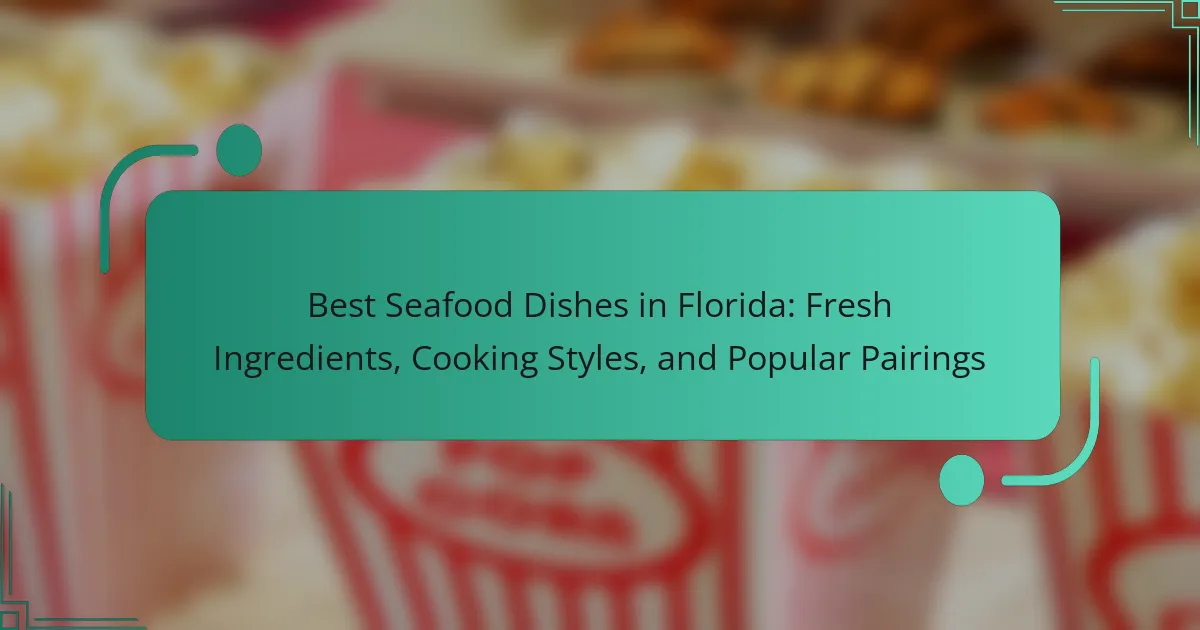Florida’s seafood is characterized by its fresh ingredients and diverse culinary influences, featuring key dishes such as Key West pink shrimp, stone crab claws, and blackened fish. These dishes are celebrated for their unique flavors and preparation methods, reflecting the state’s rich marine ecosystems and sustainable fishing practices. Popular seafood offerings also include clam chowder, conch fritters, and fried calamari, showcasing a blend of traditional Southern and Caribbean styles. Coastal cities like Miami, Key West, and Tampa are renowned for their seafood restaurants, where visitors can enjoy local specialties and participate in seafood festivals. Engaging with local fishermen and exploring food tours further enhances the experience of Florida’s vibrant seafood culture.

What are the Best Seafood Dishes in Florida?
The best seafood dishes in Florida include Key West pink shrimp, stone crab claws, and blackened fish. Key West pink shrimp are known for their sweet flavor and are often served grilled or in seafood tacos. Stone crab claws are a seasonal delicacy, typically served chilled with mustard sauce. Blackened fish, often made with snapper or grouper, features a spicy seasoning and is usually pan-seared. Other popular dishes include clam chowder, conch fritters, and fried calamari. These dishes highlight Florida’s fresh seafood and diverse culinary influences.
How do Fresh Ingredients Influence Seafood Dishes?
Fresh ingredients significantly enhance seafood dishes by improving flavor, texture, and nutritional value. Fresh seafood retains moisture and natural flavors, leading to a more vibrant taste. Ingredients like herbs, spices, and citrus can elevate the dish’s overall profile. For instance, using freshly squeezed lemon juice brightens the flavors of grilled fish. Additionally, fresh vegetables add crunch and color, enhancing visual appeal. Nutritionally, fresh ingredients often contain higher levels of vitamins and minerals. The use of fresh ingredients aligns with culinary trends emphasizing quality and sustainability. In Florida, the access to local seafood and produce supports this practice, making dishes more authentic and flavorful.
What Types of Fresh Seafood are Commonly Used?
Commonly used types of fresh seafood include shrimp, grouper, snapper, and oysters. Shrimp are popular for their versatility and flavor. Grouper is a favored fish in Florida for its mild taste and flaky texture. Snapper, especially red snapper, is prized for its delicate flavor and is often grilled or baked. Oysters are enjoyed raw or cooked and are a staple in coastal cuisine. These seafood types are abundant in Florida’s waters, contributing to the state’s vibrant culinary scene.
How do Seasonal Ingredients Impact Flavor Profiles?
Seasonal ingredients significantly impact flavor profiles by providing freshness and variety. Fresh produce during specific seasons enhances taste and nutritional value. For instance, summer brings ripe tomatoes and basil, which add sweetness and depth to dishes. In contrast, winter ingredients like citrus fruits introduce acidity and brightness. Seasonal availability also influences the preparation methods, as certain ingredients lend themselves to grilling or roasting. The use of local, seasonal seafood, such as snapper in spring, contributes to unique flavor combinations. Research shows that seasonal ingredients often contain higher levels of flavor compounds due to optimal growing conditions. This results in more vibrant and complex dishes that reflect the local environment and culinary traditions.
What Cooking Styles are Popular for Seafood in Florida?
Grilling, frying, and steaming are popular cooking styles for seafood in Florida. Grilling enhances the natural flavors of fish and shellfish. It is commonly done outdoors, especially during the warm months. Frying, often used for dishes like fried shrimp or fish sandwiches, provides a crispy texture. Steaming is a healthier option that retains moisture and nutrients. These methods reflect Florida’s coastal influence and culinary traditions. Local seafood markets supply fresh ingredients for these cooking styles. The vibrant food culture in Florida celebrates these techniques through various regional dishes.
How Does Grilling Enhance the Taste of Seafood?
Grilling enhances the taste of seafood by imparting a smoky flavor and creating a desirable char. The high heat of grilling caramelizes the natural sugars in seafood, enhancing its sweetness. This cooking method also allows moisture to be retained, preventing the seafood from drying out. Grilling can intensify the natural flavors of fish and shellfish, making them more pronounced. Additionally, the Maillard reaction occurs during grilling, adding complexity to the flavor profile. Studies show that grilling can elevate the overall sensory experience of seafood dishes. This is particularly true for popular seafood in Florida, where fresh ingredients are abundant. The combination of grilling with local seafood creates unique and flavorful dishes.
What Role Does Frying Play in Florida Seafood Dishes?
Frying plays a significant role in Florida seafood dishes by enhancing flavor and texture. This cooking method creates a crispy exterior while keeping the seafood moist inside. Popular fried seafood options include shrimp, grouper, and oysters. Frying also allows for the incorporation of local seasonings and batters, adding unique regional flavors. The technique is often associated with traditional Southern cuisine, which is prevalent in Florida. Furthermore, the state’s access to fresh seafood makes frying a popular choice among chefs and home cooks alike. Fried seafood dishes are commonly served with sides like coleslaw and tartar sauce, complementing the main ingredient. Overall, frying is a key cooking style that showcases Florida’s seafood bounty.
What are the Most Popular Pairings with Seafood?
The most popular pairings with seafood include lemon, garlic, and herbs. Lemon enhances the freshness of seafood. Garlic adds depth of flavor. Herbs like dill and parsley complement various fish dishes. Additionally, butter is a classic choice for richness. White wine is often paired to elevate the dining experience. Side dishes like rice and vegetables balance the meal. These pairings are widely recognized in culinary traditions, especially in coastal regions.
Which Side Dishes Complement Florida Seafood Best?
Classic side dishes that complement Florida seafood include coleslaw, rice, and fried plantains. Coleslaw provides a crunchy texture and balances the flavors of seafood. Rice, especially seasoned or coconut rice, absorbs sauces well. Fried plantains add a sweet contrast to savory seafood dishes. Additionally, grilled vegetables enhance the meal with freshness. These sides are commonly served in Florida restaurants, showcasing local culinary traditions.
How Do Sauces Enhance Seafood Flavors?
Sauces enhance seafood flavors by adding complementary tastes and textures. They can introduce acidity, sweetness, or spiciness, which balance the natural flavors of seafood. For instance, citrus-based sauces like lemon butter brighten the dish. Creamy sauces, such as garlic aioli, add richness that contrasts with lighter seafood. Marinades can infuse seafood with additional flavors before cooking. Herbs and spices in sauces can elevate the overall taste profile. Studies show that pairing sauces with seafood can improve overall dining satisfaction. Therefore, sauces play a crucial role in enhancing the dining experience of seafood dishes.

What Makes Florida Seafood Unique?
Florida seafood is unique due to its diverse marine ecosystems and abundant species. The state’s coastal waters support a variety of fish, shellfish, and crustaceans. Key species include grouper, snapper, stone crab, and shrimp. Florida’s warm climate allows for year-round fishing and harvesting. The region is known for its sustainable fishing practices, which help preserve marine life. Additionally, Florida seafood is often prepared with fresh, local ingredients. This enhances the natural flavors of the seafood. The culinary styles in Florida range from traditional Southern to Caribbean influences. These factors contribute to the distinctiveness of Florida seafood in the culinary world.
How Does Geography Influence Seafood Cuisine?
Geography significantly influences seafood cuisine by determining the types of fish and shellfish available. Coastal regions have access to a variety of seafood that inland areas do not. For example, Florida’s warm waters provide a habitat for species like grouper and snapper. These fish are staples in local dishes, reflecting regional availability. Additionally, geographical features like estuaries and mangroves support diverse aquatic life. This diversity shapes local culinary traditions and cooking methods, such as grilling or frying. Furthermore, the proximity to fishing ports affects the freshness of seafood, enhancing the overall dining experience. Regions with a strong fishing culture often have unique recipes and preparation styles that highlight local catches.
What Coastal Regions Contribute to Florida’s Seafood Variety?
Florida’s seafood variety is significantly contributed by its coastal regions, including the Gulf Coast, Atlantic Coast, and the Florida Keys. The Gulf Coast is known for its rich fisheries, yielding shrimp, oysters, and various fish species. The Atlantic Coast provides a diverse catch, including snapper, grouper, and tuna. The Florida Keys are famous for their lobster and conch, adding unique flavors to the seafood scene. Each coastal region’s distinct ecosystem supports different marine life, enhancing Florida’s overall seafood diversity. The state’s abundant waters are home to over 1,000 species of fish, making it a prime location for seafood harvesting.
How Do Local Fishing Practices Shape Seafood Availability?
Local fishing practices significantly influence seafood availability. These practices determine which species are caught and in what quantities. Sustainable fishing methods ensure that fish populations remain healthy. Overfishing can lead to a decline in certain species, affecting availability. Seasonal fishing practices align with breeding cycles, allowing populations to recover. Local regulations may restrict certain fishing methods to protect marine ecosystems. Community involvement in fishing practices fosters a sense of stewardship. Studies show that areas with sustainable practices have higher seafood diversity. Therefore, local fishing practices play a crucial role in shaping the seafood supply.
What Cultural Influences are Reflected in Florida Seafood Dishes?
Florida seafood dishes reflect a blend of various cultural influences. These influences include Native American, Spanish, African, and Caribbean cuisines. Native American traditions contribute local fish and shellfish preparation methods. Spanish influence is evident in the use of spices and cooking techniques, such as paella. African culinary traditions introduce flavors and ingredients like okra and spices. Caribbean cuisine influences Florida seafood through the incorporation of tropical fruits and bold seasonings. The state’s diverse population has led to a fusion of these culinary styles. This cultural melting pot results in unique dishes that highlight Florida’s rich seafood heritage.
How Does Florida’s Diverse Population Affect Seafood Recipes?
Florida’s diverse population significantly influences its seafood recipes. The state’s multicultural communities bring unique culinary traditions and flavors. For example, Caribbean, Hispanic, and Southern cuisines blend with local seafood. This results in dishes like ceviche, seafood paella, and gumbo. Each recipe reflects the cultural heritage of its creators. Additionally, the variety of seafood available encourages experimentation. Local ingredients are often paired with international spices and cooking techniques. This fusion creates a vibrant and evolving seafood scene in Florida.
What Historical Factors Contribute to Florida’s Seafood Traditions?
Florida’s seafood traditions are shaped by its geographical location, diverse cultures, and historical developments. The state’s extensive coastline provides access to a rich variety of marine life. Indigenous communities relied on local fish and shellfish for sustenance long before European contact. The arrival of Spanish explorers in the 16th century introduced new fishing techniques and species. Over time, waves of immigrants brought their culinary traditions, further enriching Florida’s seafood culture. The development of the fishing industry in the 19th century established commercial fishing practices. Events like hurricanes have also influenced fishing patterns and availability. Today, Florida remains a leading producer of seafood in the United States, with traditions reflecting its historical influences.

How Can You Experience the Best Seafood Dishes in Florida?
To experience the best seafood dishes in Florida, visit renowned seafood restaurants along the coast. Key locations include Miami, Key West, and Tampa, known for their fresh catches. Sample local specialties like stone crab, grouper, and shrimp. Participate in seafood festivals that celebrate regional cuisine. Engage with local fishermen for insight into sustainable practices. Consider dining at waterfront venues for scenic views. Explore food tours that highlight diverse cooking styles. Enjoy dishes prepared with fresh, seasonal ingredients for optimal flavor.
What are the Top Restaurants for Seafood in Florida?
The top restaurants for seafood in Florida include Joe’s Stone Crab, The Fish House, and The Capital Grille. Joe’s Stone Crab in Miami Beach is famous for its stone crab claws and has been a local favorite since 1913. The Fish House in Key Largo offers a casual dining experience with fresh catch daily. The Capital Grille, located in multiple cities, is known for its upscale seafood options and extensive wine list. Each of these restaurants emphasizes fresh, local ingredients and has received numerous accolades for their seafood dishes.
How Do Reviews and Ratings Help in Choosing the Best Seafood Spots?
Reviews and ratings provide essential insights when choosing the best seafood spots. They reflect the experiences of previous customers. High ratings often indicate quality food and service. Reviews detail specific dishes, helping diners identify popular options. They can highlight freshness, taste, and preparation methods. Negative reviews may warn about issues like poor hygiene or service delays. Many consumers trust online platforms for seafood recommendations. Research shows that 84% of people trust online reviews as much as personal recommendations. Thus, reviews and ratings significantly influence dining decisions.
What Signature Dishes Should You Try at These Restaurants?
Key signature dishes to try at Florida seafood restaurants include the Blackened Mahi-Mahi. This dish features fresh fish seasoned with a blend of spices. Another must-try is the Key West Shrimp, known for its sweet flavor and tender texture. The Shrimp and Grits dish is also popular, combining creamy grits with sautéed shrimp. Grilled Snapper is a favorite, often served with tropical fruit salsa. Additionally, the Lobster Roll showcases sweet lobster meat in a buttery bun. Lastly, the Clam Chowder stands out for its rich, creamy base and hearty clams. These dishes highlight the diverse seafood offerings in Florida, emphasizing fresh ingredients and regional cooking styles.
What Tips Can Enhance Your Seafood Dining Experience?
To enhance your seafood dining experience, focus on freshness and quality. Choose restaurants known for sourcing local seafood. Fresh seafood often tastes better and retains more nutrients. Pair your seafood with complementary sides and sauces. This can elevate the overall flavor profile. Consider the type of seafood and its preparation style. Grilled, steamed, or fried methods can affect taste and texture. Ask your server for recommendations based on seasonal specials. Seasonal seafood is usually fresher and more flavorful. Lastly, enjoy your meal with a suitable beverage. Wine or craft beer can enhance the dining experience.
How to Choose the Freshest Seafood When Dining Out?
Choose seafood that appears moist and shiny. Fresh seafood should have a clean, ocean-like smell. Look for clear eyes in whole fish; this indicates freshness. Firm texture is essential; press the flesh and it should bounce back. Check for bright, vibrant colors in the flesh. Avoid seafood with dull or discolored skin. Inspect the gills; they should be bright red or pink. Ensure the restaurant has a good reputation for sourcing quality seafood.
What Etiquette Should You Follow When Enjoying Seafood?
When enjoying seafood, proper etiquette includes several key practices. First, use utensils appropriately; seafood is often messy, so having a fork and knife is essential. When eating shellfish, it is polite to use your hands for convenience. If provided, utilize seafood forks for easier consumption.
Next, avoid loud noises while eating. Chewing quietly and not slurping enhances the dining experience for everyone. Always keep your napkin on your lap and use it to dab your mouth as needed.
When dining in a group, wait for everyone to be served before starting your meal. This shows respect for others at the table. If sharing dishes, use serving utensils to avoid contamination.
Finally, be mindful of your seafood choices; some diners may have allergies or dietary restrictions. Always inquire about preferences before ordering shared plates. These etiquette practices contribute to a pleasant dining atmosphere when enjoying seafood.
The main entity of the article is the best seafood dishes in Florida, highlighting a variety of popular options such as Key West pink shrimp, stone crab claws, and blackened fish. The article explores the influence of fresh ingredients on flavor, the common types of seafood used, and the impact of seasonal ingredients on culinary profiles. It also discusses popular cooking styles like grilling and frying, essential pairings, and signature dishes at top restaurants. Additionally, the article examines how geography, local fishing practices, and cultural influences shape Florida’s unique seafood cuisine.



